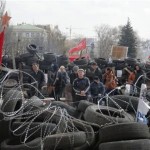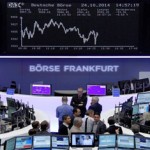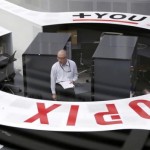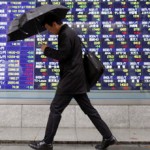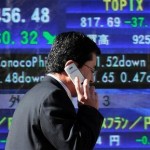Nikkei surges 7%, Topix up 8.3%; China lose ground
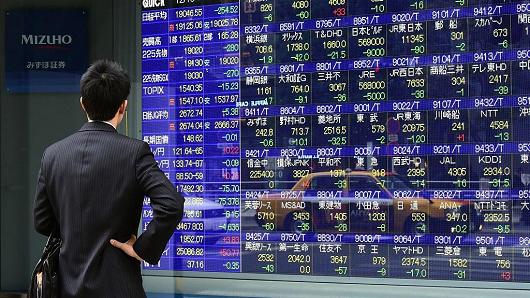
Asian stocks mostly climbed on Monday, with Japan shares surging after last week’s sharp selloff. But China’s shares lost ground as its markets re-opened after the week-long Lunar New Year holiday.
The Nikkei 225 retraced losses some of Friday’s losses, jumping 6.70 percent, and the Topix surged 7.84 percent in morning trade. The Nikkei had lost as much as 12.88 percent between February 1-12.
Bucking the regional trend, mainland Chinese markets opened lower, with the Shanghai composite falling 1.57 percent and the Shenzhen composite dropping 1.2 percent. That disappointed analysts’ expectations that the rally in U.S. and Europe on Friday and recent comments made by People’s Bank of China (PBOC) governor Zhou Xiaochuan on the yuan might have a positive impact on trade.
The yuan hit its strongest level against the dollar for 2016 as the dollar-yuan pair traded down 1.09 percent at 6.4995.
Over the weekend, Zhou told Caixin financial magazine that he saw no basis for a continuing the depreciation of the yuan, also known as the renminbi. He also dismissed speculation that Beijing would tighten capital controls to stem the surging capital outflows from the mainland.
Trade data for January, however, showed a far bigger slide than expected by analysts. Exports for the month fell 11.2 percent on year, compared to analyst estimates of a 1.9 percent drop, according to a Reuters poll. Imports tumbled 18.8 percent compared to a market estimate of 0.8 percent drop.
In South Korea, the Kospi was up 1.39 percent.
Down Under, the S&P/ASX 200 was 1.25 percent higher. The index was buoyed by gains in the materials sector, which was up 4.25 percent, and the energy sector, which gained 2.13 percent. Resources producers were mostly up, except gold miners, with the likes of Rio Tinto gaining 4.08 percent and BHP Billiton up by 5.70 percent.
Banking stocks across the region traded mostly higher, following gains for their counterparts in the U.S. and Europe on Friday.
Australia’s so-called Big Four banks – ANZ, Commonwealth Bank of Australia, Westpac and NAB – traded up between 0.85 and 2.59 percent.
Japanese banks, which have sold off sharply since the Bank of Japan’s surprise decision to introduce negative interest rates toward the end of January, rallied, with Mitsubishi UFJ up 8.74 percent, SMFG gaining 10.72 percent, Mizuho Financial up 8.89 percent and Nomura up 10.75 percent.
Brokerages in South Korea were also up between 2.35 and 11.53 percent, with Samsung Securities up 4.78 percent and Daewoo Securities gaining 4 percent.
Japanese stocks rallied across the board, with sentiment getting a fillip after Kozo Yamamoto, a key Abe ally, suggested on Friday that Prime Minister Shinzo Abe needed to hold an emergency economic summitto discuss measures to address a global growth slowdown as well as market turbulence.
“An emergency meeting will be a positive,” said Evan Lucas, a market strategist at spreadbetter IG, in a morning note. “even if it’s for the wrong reasons and this remains a ‘watch this space’ moment.”
Major exporters Toyota, Nissan and Honda gained between 6.17 and 9.58 percent on the back of a stronger dollar-yen pair, which was up 0.65 percent at 113.94. Last week, it fell as low as the 111-mark. A weaker yen is a positive for exporters as this increases their overseas revenue when converted into local currency.
Japan’s trading houses, known as “sogo shosha,” which supply everything from energy to metals to grains and textiles in the resource-scarce country, all saw sharp rebounds Monday morning, trading up over 8 percent each. Among the big five, Itochu Corp was up 12.19 percent.
The economy, however, contracted at an annualized rate of 1.4 percentin the quarter from October through December, hurt by weak private consumption and housing, according to official data.
Reuters reported that the preliminary figure for GDP was higher than what the market expected – a Reuters poll had estimated a 1.2 percent contraction. In the July-September period, Japan’s revised GDP numbers showed a 1.3 percent gain.
Gavin Parry, managing director of Parry International Trading, told CNBC’s “Squawk Box” it will be interesting to see what the BOJ does policy-wise in light of today’s economic data.
“If you look at the GDP deflator, it was actually fairly in line, if not [seeing] a little bit of deceleration,” he said. “So that’s really the indication of the inflation situation. We get the feeling that [the BOJ] will probably increase their on-market purchases – the ETFs and the J-REITS – come March.”
Parry added that while there has been a heavy focus on the introduction of negative interest rates and what that might entail for the economy at large, it was more of a carrot and stick approach by the Japanese central bank.
“To us, [negative deposit rates] is more like a stick. They’ve done the carrot and it’s ongoing, that is the QQE (qualitative quantitative easing) programs,” said Parry. The move in deposit rates is a stick because it coincides with the third, more elusive arrow of Abenomics according to Parry – which is increasing real wages and capital expenditures.
“[BOJ] is trying to deploy capital and get it to work into the economy,” through negative interest rates, he said.
Oil prices again came under pressure during Asian hours. U.S. benchmark West Texas Intermediate (WTI) futures were down 0.65 percent at $29.25 a barrel after gaining 12.32 percent on Friday during U.S. hours. Brent was down 0.51 percent at $33.19 a barrel, following a 9.35 percent gain in U.S. trade on Friday. But oil prices still remain depressed and volatile.
Last week, UAE’s energy minister said OPEC was willing to cooperate on an output cut, as reported by the Wall Street Journal, and added that cheap oil was forcing supply reductions that would help re-balance the market. In recent weeks, several reports have speculated a possible supply cut from OPEC members, particularly Saudi Arabia, even as U.S. inventories continued to build up.
Energy plays traded mostly higher across the region, with Santoserasing early losses to trade up 1.90 percent, Woodside Petroleumgaining 5.41 percent, Japan’s Inpex adding 7.97 percent and S-Oil rising 0.94 percent.
Hong Kong-listed shares of CNOOC, Petrochina and Sinopec were up between 3.16 and 5.08 percent, while mainland shares of China Oilfieldslipped 1.73 percent.
This follows a higher finish on Wall Street on Friday. The Dow Jones industrial average closed up 313.66 points, or 2 percent, at 15,973.84. The S&P 500 ended up 35.70 points, or 1.95 percent, higher at 1,864.78 and the Nasdaq composite gained 70.67 points, or 1.66 percent, to close at 4,337.51.
Source: CNBC









